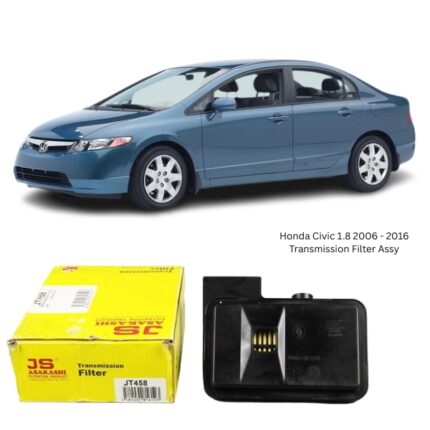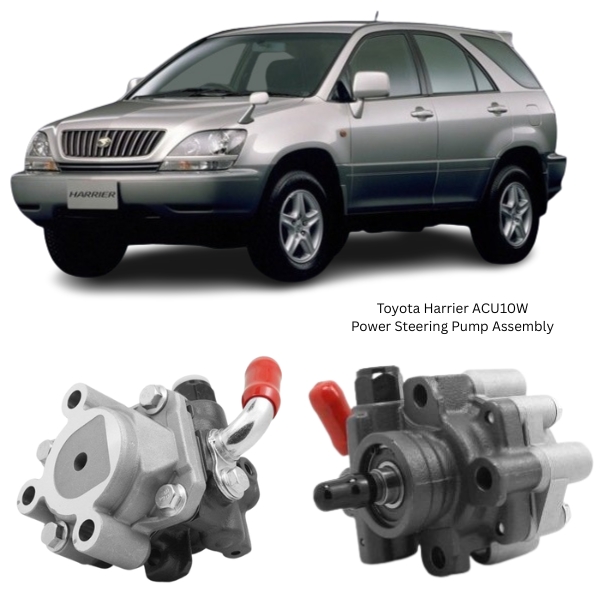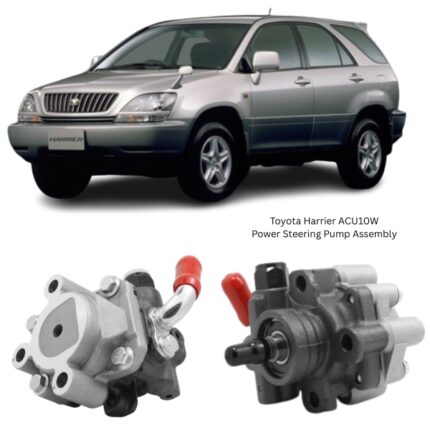Get Toyota Harrier ACU10W Power Steering Pump Assembly 44320-48040 in Kenya
The Power Steering Pump Assembly (Part No. 44320-48040) is a high-quality hydraulic component designed to provide smooth, responsive, and controlled steering performance. It plays a central role in the power steering system by delivering pressurized hydraulic fluid to the steering gear, significantly reducing the driver’s steering effort. The 44320-48040 unit is engineered for precision, durability, and reliability under a wide range of driving conditions, making it essential to steering performance and overall vehicle handling.
Manufactured using advanced engineering standards and tested for longevity and performance, this assembly is built to meet or exceed Original Equipment (OE) specifications. It is particularly suited for vehicles requiring consistent hydraulic flow and dependable steering feel, even during demanding conditions or prolonged operation.
Primary Function
The main role of the Power Steering Pump Assembly is to create and maintain hydraulic pressure within the power steering system. This pressure assists the driver by reducing the manual force required to turn the steering wheel, especially at low speeds or during parking.
Core Functions Include:
-
Hydraulic Pressure Generation:
The pump pressurizes the power steering fluid and delivers it through the hydraulic circuit to the steering gear or rack. -
Steering Assistance:
Enables easier turning of the steering wheel, particularly when the vehicle is stationary or moving at low speeds. -
Fluid Circulation:
Maintains steady circulation of power steering fluid, ensuring temperature control and component lubrication. -
System Stability:
Provides consistent steering feel and responsiveness by supplying fluid at a controlled pressure and flow rate.
When functioning correctly, the steering system becomes significantly more responsive, predictable, and comfortable for the driver.
Design and Construction
The 44320-48040 Power Steering Pump Assembly is a belt-driven hydraulic vane-type pump, engineered for continuous operation, high output, and minimal vibration.
Key Components:
-
Pump Housing:
Constructed from high-grade cast aluminum or steel for durability, lightweight performance, and corrosion resistance. -
Drive Pulley:
Belt-driven by the engine crankshaft, transferring mechanical energy to the internal pump rotor. Precision-machined for alignment and balance. -
Rotor and Vanes:
Internal rotating assembly with vanes that slide in and out to create pressure differentials, drawing in and pushing out fluid. -
Inlet and Outlet Ports:
Facilitates the flow of fluid into and out of the pump. Includes high-pressure outlet with appropriate fittings for hose connections. -
Internal Reservoir (if integrated):
Holds a limited volume of power steering fluid, although some setups rely on an external reservoir. -
Pressure Relief Valve:
Protects the system from excessive pressure build-up by redirecting fluid when necessary. -
Seals and Bearings:
Engineered for high-temperature, high-pressure environments to prevent fluid leaks and ensure smooth rotation.
All components are precision-aligned during manufacturing to ensure consistent output pressure, efficient operation, and long service life.
Technical Specifications
-
Part Number: 44320-48040
-
Type: Hydraulic vane pump
-
Drive Type: Pulley-driven (belt-operated)
-
Operating Pressure Range: 800–1200 psi (typical)
-
Fluid Compatibility: Power steering hydraulic fluid (consult specification guide)
-
Mounting Configuration: Engine-side mount with bolt-on fitment
-
Rotation Direction: Clockwise or counterclockwise (dependent on engine layout)
-
Construction: Cast aluminum housing with steel internal rotor
-
Includes: Pump body, pulley (in some variants), pressure relief valve, and inlet/outlet ports
The part is built to fit and perform seamlessly within compatible power steering systems, ensuring efficient hydraulic delivery and long-term reliability.
Performance Characteristics
The 44320-48040 Power Steering Pump Assembly is designed to provide:
-
Immediate Hydraulic Response:
Delivers pressurized fluid instantly on demand, ensuring smooth and easy steering effort. -
Consistent Pressure Delivery:
Maintains uniform pressure output across various engine speeds and operating conditions. -
Quiet Operation:
Engineered for minimal noise and vibration, with precision-balanced rotors and optimized fluid channels. -
Thermal Resistance:
Operates effectively under elevated engine bay temperatures without loss of efficiency. -
Leak-Free Sealing:
Reinforced seals and gaskets ensure that hydraulic fluid remains contained and protected from contaminants. -
Vibration Dampening:
Designed to absorb engine and road vibrations, preventing premature component fatigue.
These qualities are essential for maintaining driver comfort and vehicle control during turns, lane changes, and parking maneuvers.
Common Signs of Wear or Failure
Failure of the power steering pump can lead to increased steering effort and system inefficiencies. Key symptoms include:
-
Whining or Groaning Noises:
Typically heard during turns, caused by low fluid levels or internal pump wear. -
Hard Steering:
A sudden increase in steering effort, especially at low speeds. -
Fluid Leaks:
Hydraulic fluid around the pump body or hoses indicates failed seals or connections. -
Foamy or Discolored Fluid:
May signal air ingestion into the system due to a failing pump or low fluid. -
Inconsistent Steering Response:
Intermittent power assist or pulsating feedback through the steering wheel.
Early identification of these symptoms and timely replacement with a new 44320-48040 assembly can prevent broader system failure and safety risks.
Installation Overview
Professional installation is recommended due to the hydraulic nature of the system and the need for precision alignment and pressure management. General installation steps include:
-
Drain the Power Steering System:
Safely remove old fluid and depressurize the system. -
Remove the Drive Belt:
Detach the belt connected to the pump pulley. -
Disconnect Hydraulic Lines:
Use line wrenches to disconnect pressure and return hoses, catching fluid for disposal. -
Unbolt and Remove the Old Pump:
Take note of mounting hardware and bracket configuration. -
Install the New Pump Assembly:
Bolt securely into place, aligning the pulley with the drive belt path. -
Reconnect Hydraulic Lines:
Ensure tight, leak-free connections using correct torque values. -
Refill System with Approved Fluid:
Bleed air by turning the steering wheel lock-to-lock multiple times with the engine off and on. -
Check for Leaks and Function:
Ensure consistent steering assist and quiet operation under various conditions.
Proper system bleeding and belt tension adjustment are critical to optimal performance and longevity.
Maintenance and Care
While the pump itself is relatively low-maintenance, the system relies on regular upkeep to extend its service life:
-
Use Correct Fluid Type:
Always refill with manufacturer-specified fluid. -
Check Fluid Levels Regularly:
Low fluid causes cavitation and rapid wear. -
Inspect for Leaks:
Regularly inspect hoses, seals, and connections. -
Replace Fluid Periodically:
Old fluid can contain debris or lose lubrication properties. -
Avoid Holding Steering at Full Lock:
This increases system pressure and can strain the pump.
Follow us on Facebook for more parts.





Reviews
Clear filtersThere are no reviews yet.